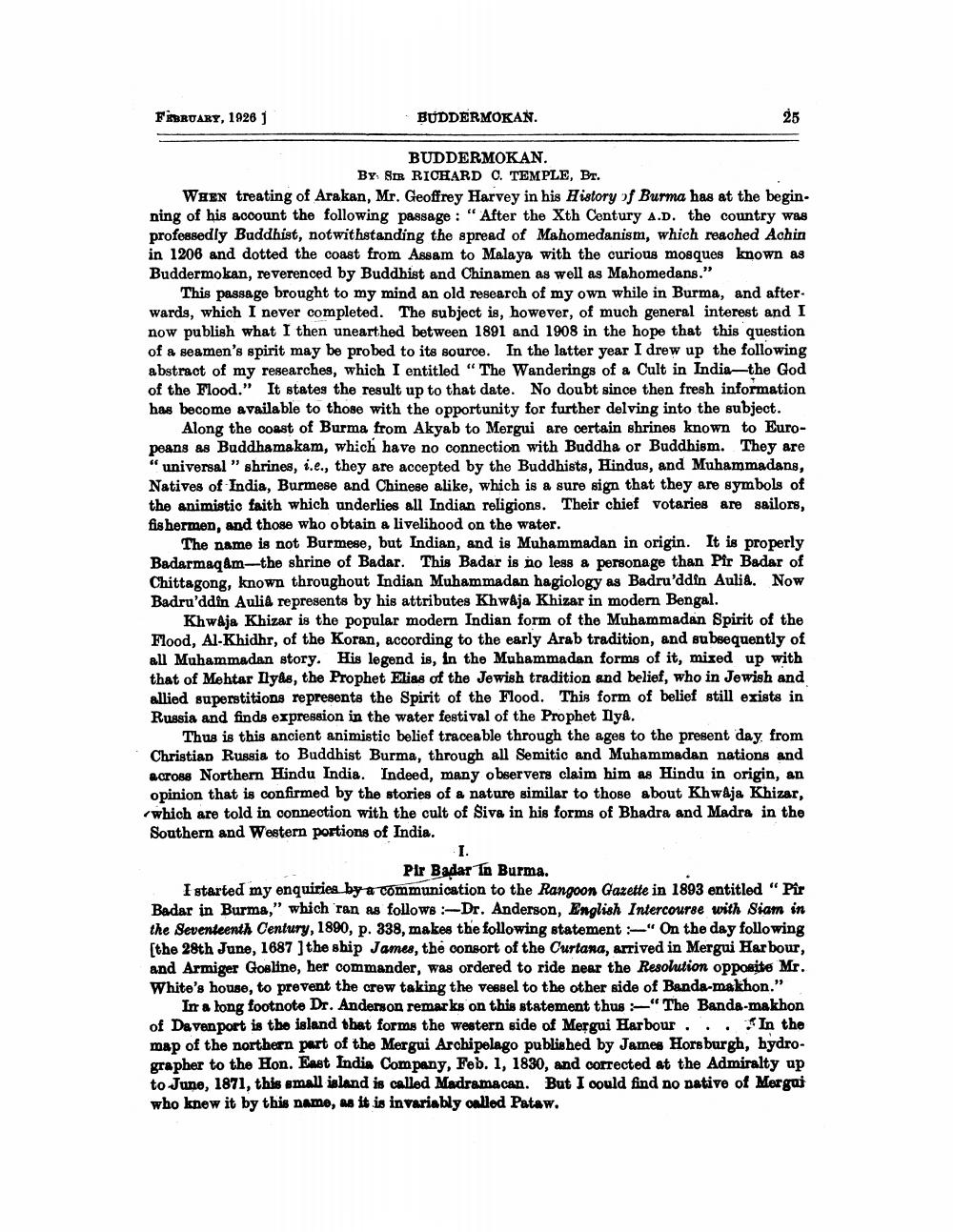________________
FEBRUARY, 1926 j
25
BUDDERMOKAN.
BUDDERMOKAN.
BY SIR RICHARD C. TEMPLE, BT.
WHEN treating of Arakan, Mr. Geoffrey Harvey in his History of Burma has at the begin. ning of his account the following passage: "After the Xth Century A.D. the country was professedly Buddhist, notwithstanding the spread of Mahomedanism, which reached Achin in 1206 and dotted the coast from Assam to Malaya with the curious mosques known as Buddermokan, reverenced by Buddhist and Chinamen as well as Mahomedans."
This passage brought to my mind an old research of my own while in Burma, and afterwards, which I never completed. The subject is, however, of much general interest and I now publish what I then unearthed between 1891 and 1908 in the hope that this question of a seamen's spirit may be probed to its source. In the latter year I drew up the following abstract of my researches, which I entitled "The Wanderings of a Cult in India-the God of the Flood." It states the result up to that date. No doubt since then fresh information has become available to those with the opportunity for further delving into the subject.
Along the coast of Burma from Akyab to Mergui are certain shrines known to Europeans as Buddhamakam, which have no connection with Buddha or Buddhism. They are "universal" shrines, i.e., they are accepted by the Buddhists, Hindus, and Muhammadans, Natives of India, Burmese and Chinese alike, which is a sure sign that they are symbols of the animistic faith which underlies all Indian religions. Their chief votaries are sailors, fishermen, and those who obtain a livelihood on the water. The name is not Burmese, but Indian, and is Muhammadan in origin. It is properly Badarmaqam-the shrine of Badar. This Badar is no less a personage than Pir Badar of Chittagong, known throughout Indian Muhammadan hagiology as Badru'ddîn Aulia. Now Badru'ddin Aulia represents by his attributes Khwaja Khizar in modern Bengal.
Khwaja Khizar is the popular modern Indian form of the Muhammadan Spirit of the Flood, Al-Khidhr, of the Koran, according to the early Arab tradition, and subsequently of all Muhammadan story. His legend is, in the Muhammadan forms of it, mixed up with that of Mehtar Ilyas, the Prophet Elias of the Jewish tradition and belief, who in Jewish and allied superstitions represents the Spirit of the Flood. This form of belief still exists in Russia and finds expression in the water festival of the Prophet Ilya.
Thus is this ancient animistic belief traceable through the ages to the present day from Christian Russia to Buddhist Burma, through all Semitic and Muhammadan nations and across Northern Hindu India. Indeed, many observers claim him as Hindu in origin, an opinion that is confirmed by the stories of a nature similar to those about Khwaja Khizar, which are told in connection with the cult of Siva in his forms of Bhadra and Madra in the Southern and Western portions of India.
I.
Pir Badar In Burma.
I started my enquiries by a communication to the Rangoon Gazette in 1893 entitled "Pîr Badar in Burma," which ran as follows:-Dr. Anderson, English Intercourse with Siam in the Seventeenth Century, 1890, p. 338, makes the following statement :-" On the day following [the 28th June, 1687 ] the ship James, the consort of the Curtana, arrived in Mergui Harbour, and Armiger Gosline, her commander, was ordered to ride near the Resolution opposite Mr. White's house, to prevent the crew taking the vessel to the other side of Banda-makhon."
In a long footnote Dr. Anderson remarks on this statement thus :-"The Banda-makhon of Davenport is the island that forms the western side of Mergui Harbour... In the map of the northern part of the Mergui Archipelago published by James Horsburgh, hydrographer to the Hon. East India Company, Feb. 1, 1830, and corrected at the Admiralty up to June, 1871, this small island is called Madramacan. But I could find no native of Mergui who knew it by this name, as it is invariably called Pataw.




